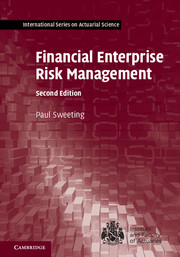Book contents
- Frontmatter
- Contents
- Preface
- 1 An Introduction to Enterprise Risk Management
- 2 Types of Financial Institution
- 3 Stakeholders
- 4 The Internal Environment
- 5 The External Environment
- 6 Process Overview
- 7 Definitions of Risk
- 8 Risk Identification
- 9 Some Useful Statistics
- 10 Statistical Distributions
- 11 Modelling Techniques
- 12 Extreme Value Theory
- 13 Modelling Time Series
- 14 Quantifying Particular Risks
- 15 Risk Assessment
- 16 Responses to Risk
- 17 Continuous Considerations
- 18 Economic Capital
- 19 Risk Frameworks
- 20 Case Studies
- 21 Solutions to Questions
- References
- Index
2 - Types of Financial Institution
Published online by Cambridge University Press: 12 August 2017
- Frontmatter
- Contents
- Preface
- 1 An Introduction to Enterprise Risk Management
- 2 Types of Financial Institution
- 3 Stakeholders
- 4 The Internal Environment
- 5 The External Environment
- 6 Process Overview
- 7 Definitions of Risk
- 8 Risk Identification
- 9 Some Useful Statistics
- 10 Statistical Distributions
- 11 Modelling Techniques
- 12 Extreme Value Theory
- 13 Modelling Time Series
- 14 Quantifying Particular Risks
- 15 Risk Assessment
- 16 Responses to Risk
- 17 Continuous Considerations
- 18 Economic Capital
- 19 Risk Frameworks
- 20 Case Studies
- 21 Solutions to Questions
- References
- Index
Summary
Introduction
Whilst ERM can be applied to any organisation, this book focusses on financial institutions, concentrating on the following four broad categories of organisation:
• banks;
• insurance companies;
• pension schemes; and
• foundations and endowments.
There is, of course, an enormous range of financial institutions, many of which are not covered in as much detail as those above. For example, investment (or asset) managers are an important feature of the financial landscape. However, their involvement with financial markets does not involve taking significant balance sheet risk in relation to the investment decisions made; rather, investment managers are responsible for investing assets on behalf of institutions and individuals. As such, their main role is as agent. A similar argument can be made for brokers, whose aim is typically to act on behalf of clients when trading securities.
It is also important to note that there are links between the four institutions listed above. Insurance companies will frequently sell policies to pension schemes, sometimes even taking on all liability for pension scheme members. Furthermore, banks will have both insurance companies and pension schemes as clients.
Before looking at the risks that these four organisations face, it is important to understand their nature. By looking at the business that they conduct and the various relationships they have, the ways in which they are affected by risk can be appreciated more fully. This is the first – and broadest – aspect of the context within which the risk management process is carried out.
Banks
A direct line can be drawn to current commercial banks from the merchant banks that originated in Italy in the twelfth century. These organisations provided a way for businessmen to invest their accumulated wealth: bankers lent their own money to merchants, occasionally supplemented by additional funds that they had themselves borrowed. The provision of funds to commercial enterprises remains a core business of commercial banks today.
By the thirteenth century, bankers from Lombardy in Italy were also operating in London. However, a series of bankruptcies resulted in the Lombard bankers leaving the United Kingdom towards the end of the sixteenth century, at which point they were replaced by Tudor and Stuart goldsmiths. These goldsmiths had moved away from their traditional business of fashioning items from gold, starting instead to take custody of customers’ gold for safekeeping.
- Type
- Chapter
- Information
- Financial Enterprise Risk Management , pp. 11 - 19Publisher: Cambridge University PressPrint publication year: 2017



